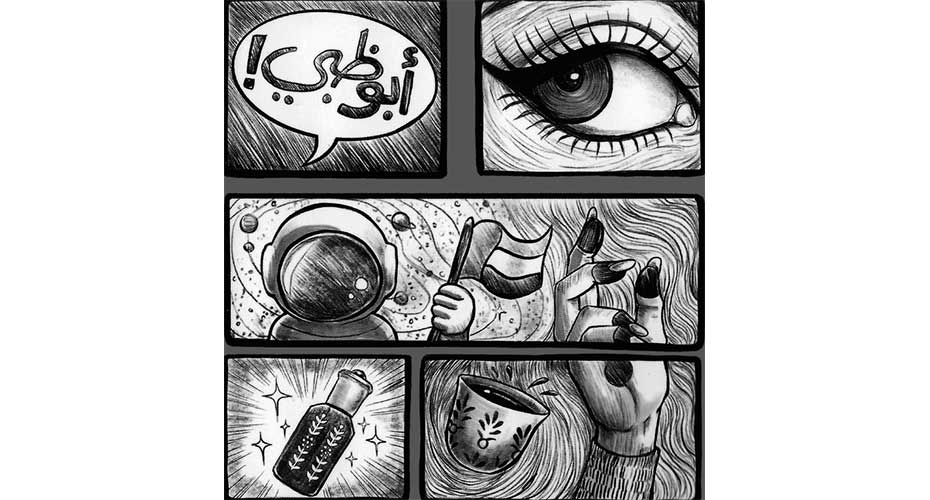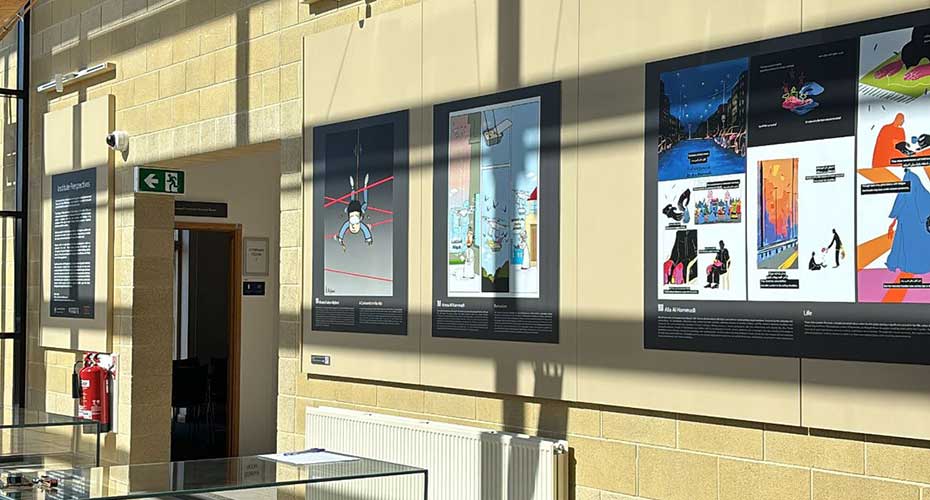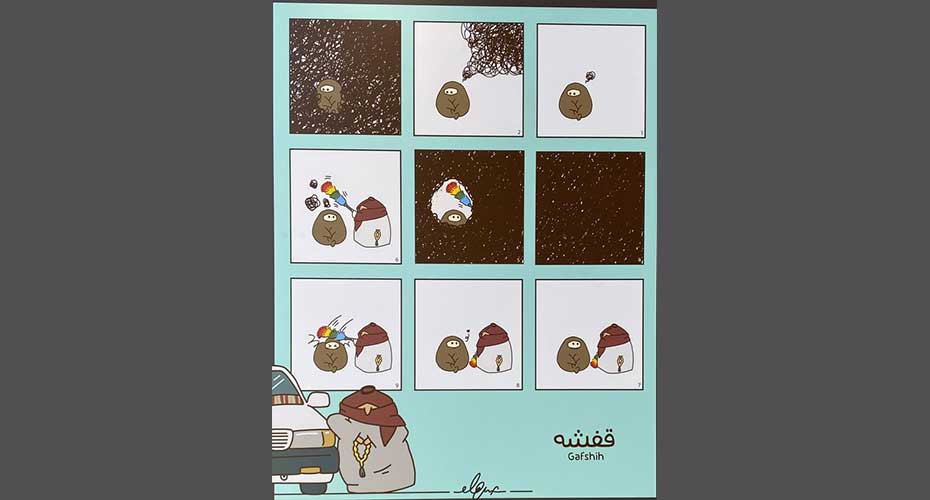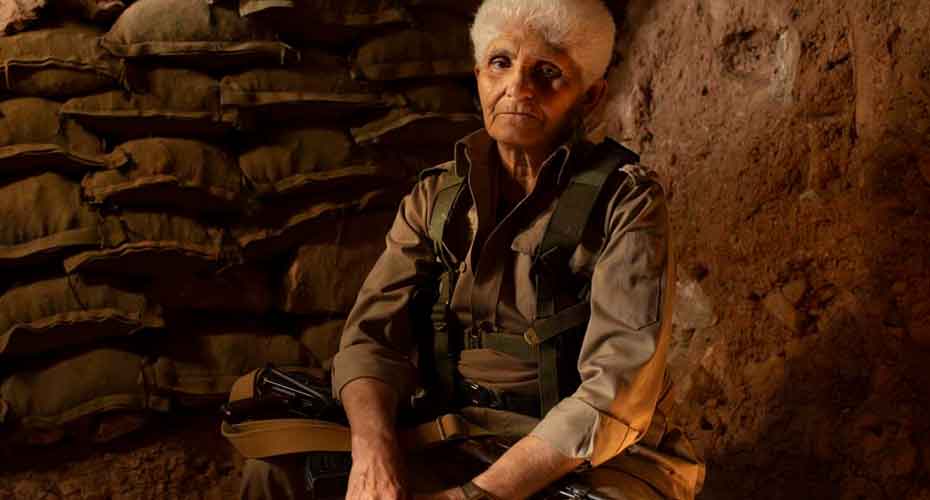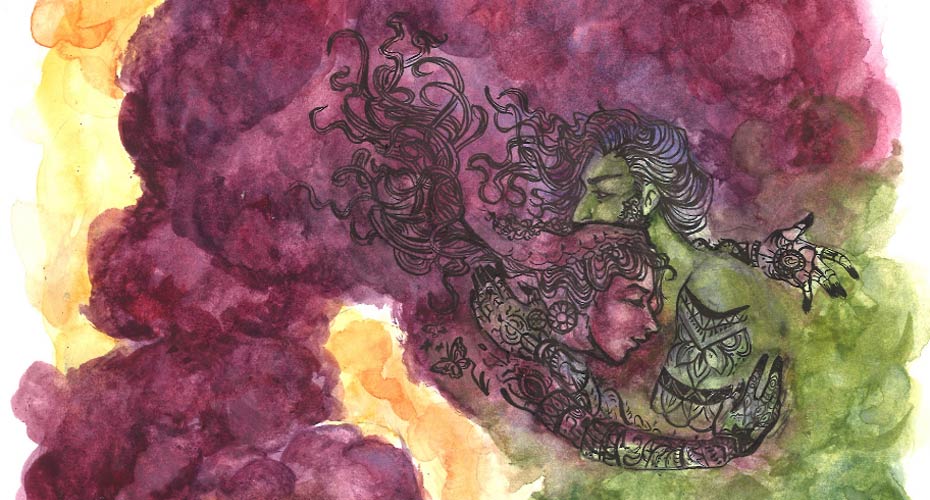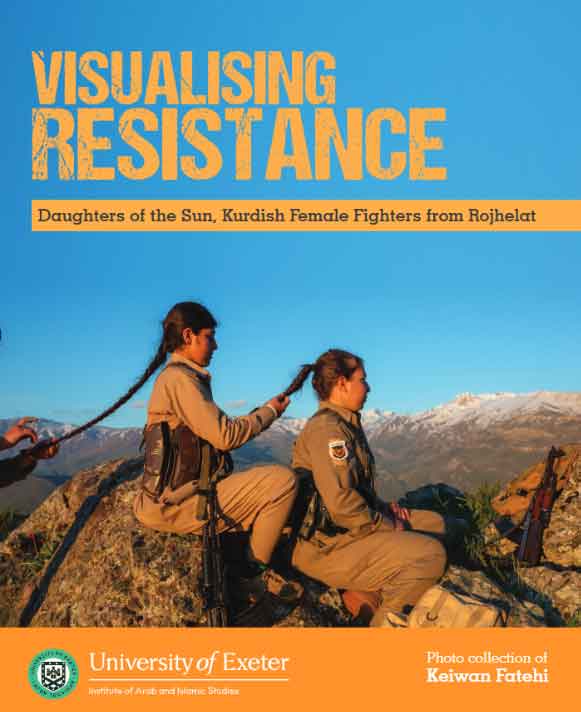Exhibitions at The Street Gallery, IAIS
The Emergence of Emirati Comics & Illustrations: ‘Between the Lines’ of visual and conceptual expression.
Localised comics, illustrations, and graphic novels are relatively new art forms in the United Arab Emirates. With the growing global reach and the networks established by localised artists, Emirati illustrators are now emerging as a recognised movement. The exhibition ‘Between the Lines’ highlights this emergence, blending diverse influences into new forms of self-expression that reflect the identities of a representative group of 18 Emirati illustrators and comic creators.
The exhibition explores the balance between technical precision and conceptual creativity, utilizing the concept of lines as both frameworks and constraints. Lines, as elements of design, can either facilitate communication by creating shapes and forms or impose limits by encapsulating and defining such shapes. In this sense, lines can represent both artistic freedom and boundaries. Within these limitations, new expressions and ideas thrive in the spaces between the lines, especially in a context where artists often calibrate and self-regulate their voices. Each comic or illustration showcased in this exhibition gives voice to what lies beyond the visible, offering insights into the dimensions of personal symbols. As a response, viewers are encouraged to uncover the hidden elements within each artifact, whether symbolic, technical, or conceptual, as they are challenged with riddles to be solved. However, the audience may search for meaning beyond what is actually there, or see depth where there might be little: the artist may have attempted to deviate from certain themes, and this is also a meaningful statement of one’s perceptions. Overall, by delving into these in-between concepts and adding personal and collective symbols to their narrative, the illustrations and comics within this exhibition, in one way or another, express ideas, meanings, and techniques that transcend the artists’ conventional ‘self’.
2 April 2025 - 28 May 2025
The Street Gallery, Institute of Arab and Islamic Studies
University of Exeter, Stocker Road, Exeter EX4 4ND
Free entry. Mon–Fri 9am–5pm
How to exhibit
The Street Gallery is part of the Institute of Arab and Islamic Studies and exhibits material culture and art with relevance to its academic interests, namely the Arab World, Middle East and Islam.
The Street is a non-commercial gallery, therefore admission is free, but administration costs are offset by a flat rate fee. It is important to note that the gallery has not been purpose-built and therefore has limitations regarding security, daylight, humidity and lighting. It is not situated in a position where the general public pass by.
Proposals for exhibitions in The Street Gallery are welcomed and will be reviewed by the Institute’s Exhibitions Committee at regular meetings. The gallery is an exhibition venue and does not normally exhibit work for sale unless designated as an Art Exhibition, when a commission charge will be applied.
If you would like to exhibit at the gallery please complete the proposal form and return it to the Insitute Administrator.
By post: The Street Gallery, Institute of Arab and Islamic Studies, Stocker Road, University of Exeter, Exeter EX4 4ND.
Telephone: +44(0)1392 72 4039
E-mail: r.l.thomson@exeter.ac.uk
Documents
Previous exhibitions
Change Square: Images of the Yemeni Revolution
31 January 2019 - 30 April 2019
By Ross Porter
This exhibition charts the life of the 2011 Yemeni Revolution through the lens of the revolutionary encampment, Change Square. It is an attempt to illustrate the multi-faceted nature of revolution, as an event of both directed political change and an ethical project at the level of the self. It is also an invitation to consider the revolutionary backdrop to the current war that is raging throughout the country; to think about the tragedy of revolution and how it blurs with war and crisis.
Masked Faces: Untold Stories from the Arabian-Persian Gulf
This exhibition ran from 06 July - 26 September 2018
By Manami Goto, a PhD student at the Institute of Arab and Islamic Studies
The female face mask, regionally known as burqu' or baṭūla, is a part of the traditional but disappearing material culture of the Arabian-Persian Gulf. Each face mask ia handmade to fit the wearer's face and conveys and intricate amound of socio-cultural detail about the wearer. The shape, colour, material, design, and embroidery are selected depending on the wearer's age, origin, marital status, ethnicity, religious or tribal affiliation, number of children, and socio-economic status. Wearing the face mask is also strongly associated with honour, piety, and pride. Through the presentation of material collections and photographs of masked women, this exhibition intends to shed light on the women in the region and their intimate and unique relationships with their masks.
Graceful Runes by Dahlia Mahmoud
This exhibition ran from 12 April - 13 June 2018
A photographic series on Language, Calligraphy and Design by Dahlia Mahmoud.
Travelling through the Arabian Gulf, hearing stories passed on from mothers to their daughters like heirlooms triggered this series of images. Matters of faith and survival, urban legends and heroic figurines in local accents find their way to patterns, amulets and the amended adornment of tribes. The common trait to the stories is the essence of strength and survival. The route and type of language (colloquial or accents) change, but the cadence and kindred nature from tribe to tribe and country to country remain similar. The photographs of the women and the superimposed letters, text and texture and layered histories, are viewed in this series.
Remembering the dead in Bahraini Shia Cemeteries.
This exhibition ran from 18 January 2018 to 28 March 2018 and was presented by Professor Timothy Insoll and the Centre for Islamic Archaeology.
Cemeteries are contexts in which the dead are remembered by Bahraini Shia communities through visitation, grave based commemorative practices, and material culture. Plastic flowers, incense burners, rosewater bottles, containers for watering plants, fragments of cloth wrapped around stones or other objects on the grave, and decorated flags are all items that can be left at the graveside. As an unstudied aspect of Bahraini life and illustrating the diversity of Muslim practice in Bahrain and the Gulf, the artefacts, graves, and cemeteries are represented in the exhibition by images and a small display of material culture, collected as part of a larger project recording historical gravestone inscriptions on Bahrain.
For further information please email Professor Timothy Insoll:
The Worlds of Mandaean Priests
Mandaeans, sometimes called Sabians, practise an ancient and endangered religion. Conflict in the Middle East has forced them out of their homelands in Iraq and Iran in ever greater numbers. Although Mandaeans depend on their priests for preserving religious knowledge and performing complex rituals, few than 50 priests now remain worldwide. We have interviewed priests, recorded the key rituals and shot documentary films in the largest communities of Australia and Sweden.
Our project is a collaboration between the universities of Exeter and Leiden, with the generous support of the Arcadia Fund. The data collected can be seen on an open-access digital archive at: mandaeanpriests.exeter.ac.uk.
Faith and Fortune
Monday 25 May – Friday 19 December 2015
An exhibition focussing on the use of Late Antique coinage as a platform for the promotion of the respective political and religious ideals of the Byzantine, Umayyad and Sasanian Empires.
Further details here.
Return to Kurdistan
Richard Wilding
The exhibition Return to Kurdistan shows Iraqi Kurdistan and Northern Iraq in contemporary photographs by Richard Wilding, alongside historical photographs taken in the 1940s by Anthony Kersting.
Richard Wilding's photographs of Iraqi Kurdistan explore the region's ancient civilisation, documenting its religious and ethnic diversity, history of persecution and renewal, and the current refugee crisis.
Wilding's subjects include Erbil citadel, which claims to be the world's oldest continuously inhabited city, the Yezidi shrines at Lalish near Mosul and the canals built in 690 BC by King Sennacherib to take water to his famed gardens in Nineveh.
He also documents the legacy of Saddam Hussein's brutal suppression of the Kurds and the current refugee crisis in the region, which has seen up to two million displaced people seeking refuge in the Kurdistan region of Iraq.
Anthony Kersting (1916 - 2008) visited Northern Iraq and Kurdistan in 1944 and again in 1946. His photographs form an important record of minorities such as Assyrian Christians, Jews and Yezidis that inhabited the region. They also show historical sites in and around Mosul such as Nebi Yunus (Jonah's tomb) that have recently been damaged or destroyed.
Organised by the University of Exeter and Gulan, a UK charity which promotes the culture of Kurdistan.
Last Of The Dictionary Men: Stories From The South Shields Yemeni Sailors
The North East of England boasts a proud maritime and industrial heritage that has all but disappeared from today’s landscape along the River Tyne. Within this heritage lies a remarkable Middle Eastern connection – South Shields is the Land of the Arabs!
Over the course of 100 years, thousands of seamen from Yemen settled in the small town of South Shields and made it their home. Successful integration of the Yemeni community, it is argued, is one of the key multiculturalism stories that the region has to offer to the nation.
In 2005, the Iranian film director, Tina Gharavi, embarked on a journey to discover the legacy of Mohammed Ali’s visit to South Shields in 1977 (one day after the Queen’s Jubilee tour to the region). While filming she met with the Yemeni elders at the Al-Azhar mosque who shared glimpses of their amazing lives, previously unknown and untold.
A series of thirteen hand-coloured portraits by the internationally renowned photographer, Youssef Nabil, captures the first generation of Yemeni sailors with the pride they embody as individuals and as a community
Bridge + Tunnel Productions has developed a unique project, engaging two international artists (Tina Gharavi and Youssef Nabil) to work collaboratively with 14 Yemeni sailors, the last survivors of the first-generation who settled in South Shields.
The Exhibition ran from Monday 24 November 2015 – Friday 29 January 2016.
Exhibition archive
- A Tale of Two Rivers
23rd February - 19th May 2017
An Exhibition by the Wye Valley Society and the Nubian Languages and Culture Project.The exhibition reflects on how the people of each river valley are dealing with threats to their environment and how they are protecting these outstanding sites of natural beauty and cultural importance.The focus of the exhibition is the importance of the environment of both the river Wye and the Nubian Nile for personal inspiration and the flourishing of intangible culture. - The Hidden Face of Iran
26th September - 16th December 2016
This exhibition presents a series of images, by French photographer Bernard Russo, which captures the everyday life of ordinary people in Iran – images rarely seen in the West where Iran is typically presented as a land of culture, religion (often fundamental), and the centre of Sharia law. - Spain and England, Juan Luis Vives and Thomas More
Monday 13th April - Wednesday 13th May
This exhibition, the first to examine Juan Luis Vives and Thomas More together, explores the personalities of these influential humanists, and the friendship between them, and in so doing illustrates the ethos of the transnational movement which they represented. - Transhumances Kurdes
January – March 2015
Pictures of pastoral life in Kurdish Turkey and Iraq by Michaël Thevenin. - Seasons of Mud
12th May - 27th June 2014
New paintings by Iraqi artist Yousif Naser – an exhibition in collaboration with the Iraqi Cultural Centre, London - Songs of the Deserts
23 October – 19 December 2014
A celebration of the desert in mosaic, calligraphy and storytelling. Artists: Elaine M Goodwin (mosaic), Mohamed Abaoubida (calligraphy), and author Richard Hamilton. - What if
16 January - 31 March 2014
Mousa al-Kordi presents a retrospective exhibition of his sculpture and paintings. - Lots to Spot
21 - 28 April 2013
Exhibition of photographs of Turkish street life by Gozde Yenipazarli and Nilay Islek. Sponsored by the Turkish Society of the University of Exeter. Lots to Spot - Islam, Trade and Politics Across the Indian Ocean
12 January - 31 March 2013
A travelling photographic exhibition produced by the British Library for ASEASUK and BIAA, supported by the British Academy. Press release ITPIndian Ocean. - Algeria(s) in France: a journey through identity
11 October - 23 November 2012
A snapshot of contemporary novelist and photographer Leïla Sebbar's photo-diary as she attempts to negotiate her troubled half Algerian and half French history. Algeria(s). - A photographic journey through Kurdish history
7 September - 5 October 2012
Chris Kutschera, a French photographer, has been covering Kurdistan for 40 years with her husband, a journalist. Showing key events and personalities encountered over these years, the work of Chris Kutschera invites you on a journey through Kurdish history. - Making Plans for Friday
11 May – 24 August 2012
Works by local artist Oliver Flexman through a combination of video, print, drawing, painting and stickers and explore our relationship and offer an opportunity to question the stereotypes that govern our perception and engagement with the Arab World. Making Plans for Friday - Makers, Menders & Materials
Wednesday 11th April – Wednesday 25th April 2012
Download the exhibition poster for further details. - behind the camera: in front the hawza
6 February – 16 March 2012
Massimiliano Fusari’s photographic exploration of the little known social space of the hawza. Download the exhibition information. - Lasting Impressions: Seals from the Islamic World
Thursday 3 September – Friday 11 November 2011
A travelling photographic exhibition from the British Library and the British Museum, which explores how Islamic seals were made and used, what was written on them and how they were decorated.
Download the Seals from the Islamic World exhibition leaflet. - From Here to Eternity: An exhibition of mosaic and calligraphy
31 January - 1 April 2011
An exhibition exploring the philosophical concept of 'from here to eternity' from the viewpoints of the English mosaic artist Elaine M. Goodwin (non-religious) and the Moroccan calligrapher Mohamed Abaoubida (Muslim). Mosaic exhibition information - The Dhow: Mastery of the Monsoon
20 September - 17 December 2010
The first exhibition dedicated to the history of the dhow to be held in the UK. The exhibition included cultural artefacts, models, full-sized vessels and images relating to the dhow trade in the western Indian Ocean, Red Sea and Arabian-Iranian Gulf.
More information- Dhow exhibition flyer (1 MB pdf document).
- Dhow exhibition website
- Journey of a lifetime - An exhibition of photographs by HRH Princess Alice, Countess of Athlone to the Kingdom of Saudi Arabia in 1938,
2 July - 14 August 2010. - The Urban Environment: Mirror and Mediator of Radicalization?, 14 – 18 June 2010.
- ANDALUSI Heritage: Images and Objects, 6 May - 11 June 2010.
- Silver legend - an exhibition showing the story of a remarkable silver coin, 1 Feb - 16 April 2010.
- - Archaeology and Culture, 22 Oct - 18 Dec 2009.
- De-Placing Future Memory, 23 Sep - 17 Oct 2009
- From Arabia to Exeter 1959-2009, 21 May - 30 June 2009.
Please also see Understanding The McLoughlin Family Exhibition - On to Pastures New by Mike Jory
- 'Knowing the Desert' W J Harding King's exploration of the Libyan Desert
- Gold Dozi : an exhibition of embroidery by the women’s group of the Refugee Support Group Devon.
- Light Variation
- Paintings of Eastern Turkish Architecture by Richard Yeomans. 9 Nov - 14 Dec 2007.
- 10 poems from Hafez, March-May 2007.
- Paradise Lost: Nubia Before the 1964 Exodus (The Hijra), photographic tribute by Professor Herman Bell 2 Nov - 9 Feb 2007.
- The Pallium Paintings, by Clare Shepherd 18 May - 1 September 2006.
- High Steel Blues, by Stella Tripp 13 March - 12 May 2006.
- Year Abroad Photography Prize 2005
- A View of Cyprus, by Jamie Hepburn 19 Jan - 3 March 2006.
- Syria Lives , by Sarah Noble 10 Oct - 9 Dec 2005.
- Aspects of Light II, by Elaine M. Goodwin 20 May - 22 July 2005
- Silence, by Sean Goddard 24 Feb - 15 April 2005
- Mosque, by Patrick Jones
- Landscape of England & Cornwall, by Toni Onley 17 June - 8 October 2004
- Pearls in the Sand, by Alan Villiers 21 May - 8 June 2004
- Al-Batin, by Mousa Al-Kordi 9 May - 14 June 2002
- Little Rugs, by Rosemary Patmore Kemble Feb - May 2002
- Soulscapes
- Beauty of Arab Costume
- Freya Stark in Southern Arabia
